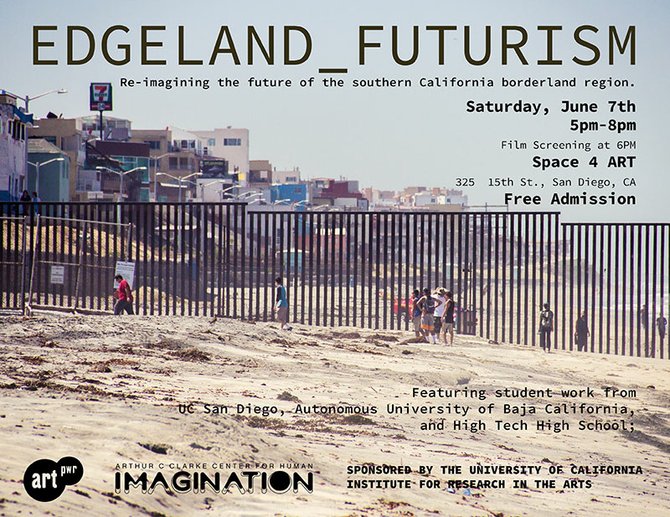 Facebook
Facebook
 X
X
 Instagram
Instagram
 TikTok
TikTok
 Youtube
Youtube

Abraham Lincoln once said, “The best way to predict the future is to create it.”
It was under this premise that Ash Eliza Smith has spent the last several months teaching an experimental course at UC San Diego, the Autonomous University of Baja California (Tijuana), and High Tech High School in Point Loma.
“We have all worked with the same prompt,” Smith says of her classes, which spanned multiple age groups and nationalities, "‘to imagine the future of the San Diego/Tijuana borderland region.’”
The late culture critic Rafa Saavedra asserted that “[Tijuana] is not a utopia or a dystopia, it's the afterparty where you hear the last call.”
Will the future of borderland south maintain its post-topian fame? Will it become mundane?
Taking her students over the international border and across the universe of science fiction literature and film, Smith invited her classes to predict the not-too-distant future of the borderland Californias in a mixed-media presentation of “Speculative Fiction and Transmissions from the Edge” titled Edgeland Futurism.
“’Edgeland’ is a term that may be used to describe a geographical location where a confluence of tensions between urban, rural, corporate, domestic and militarized zones occur,” Smith writes.
Drawing on strategies and devices from speculative fiction, Surrealist ethnography, and Situationism, Smith’s students created a series of videos, writings, sound recordings, installations, and photographs, in addition to speculative products, technologies, and performance art interventions in everyday life to predict and create the future of the edgeland.
“In this course, we [also thought] about the term ‘edgeland’ as a container to describe alterity, difference and otherness. Because the edge is proximal to the liminal, the edgeland is a place that is highly inclined to transgressions and re-formulations of ways of knowing. The assigned films and readings [engaged] critically with the duality of the edgeland as a geo-political place and as a metaphor of difference. We [focused] special attention to the strategies used in the works of feminist futurism, afrofuturism, and chicanofuturism.”
Smith argues that both “truth” and “fiction” are valid agents of potential narrative, with the later “often manifesting hopes, desires, dreams and sometimes something closer to another kind of ‘truth.’"
When asked what possible futures she foresees for the edgeland, Smith offers an appropriately nebulous slipstream word-puddle in response.
“I think somewhere in these words (to be read in a variety of ways! or even rearrange) are my hopes and fears about our potentialities as a collective: Water Demand Power Sunshine Noir in Biotech Beach Run Off Rhythm Cheap Labor Cages Some Bodies Rebel.”
Says Smith, “The future can, and needs, to be re-imagined.”
Experience the potential truths and speculative realities of Edgeland Futurism on Saturday, June 7, (5-8 p.m. at Space 4 Art. Film screening begins at 6 p.m. and admission is free.


Abraham Lincoln once said, “The best way to predict the future is to create it.”
It was under this premise that Ash Eliza Smith has spent the last several months teaching an experimental course at UC San Diego, the Autonomous University of Baja California (Tijuana), and High Tech High School in Point Loma.
“We have all worked with the same prompt,” Smith says of her classes, which spanned multiple age groups and nationalities, "‘to imagine the future of the San Diego/Tijuana borderland region.’”
The late culture critic Rafa Saavedra asserted that “[Tijuana] is not a utopia or a dystopia, it's the afterparty where you hear the last call.”
Will the future of borderland south maintain its post-topian fame? Will it become mundane?
Taking her students over the international border and across the universe of science fiction literature and film, Smith invited her classes to predict the not-too-distant future of the borderland Californias in a mixed-media presentation of “Speculative Fiction and Transmissions from the Edge” titled Edgeland Futurism.
“’Edgeland’ is a term that may be used to describe a geographical location where a confluence of tensions between urban, rural, corporate, domestic and militarized zones occur,” Smith writes.
Drawing on strategies and devices from speculative fiction, Surrealist ethnography, and Situationism, Smith’s students created a series of videos, writings, sound recordings, installations, and photographs, in addition to speculative products, technologies, and performance art interventions in everyday life to predict and create the future of the edgeland.
“In this course, we [also thought] about the term ‘edgeland’ as a container to describe alterity, difference and otherness. Because the edge is proximal to the liminal, the edgeland is a place that is highly inclined to transgressions and re-formulations of ways of knowing. The assigned films and readings [engaged] critically with the duality of the edgeland as a geo-political place and as a metaphor of difference. We [focused] special attention to the strategies used in the works of feminist futurism, afrofuturism, and chicanofuturism.”
Smith argues that both “truth” and “fiction” are valid agents of potential narrative, with the later “often manifesting hopes, desires, dreams and sometimes something closer to another kind of ‘truth.’"
When asked what possible futures she foresees for the edgeland, Smith offers an appropriately nebulous slipstream word-puddle in response.
“I think somewhere in these words (to be read in a variety of ways! or even rearrange) are my hopes and fears about our potentialities as a collective: Water Demand Power Sunshine Noir in Biotech Beach Run Off Rhythm Cheap Labor Cages Some Bodies Rebel.”
Says Smith, “The future can, and needs, to be re-imagined.”
Experience the potential truths and speculative realities of Edgeland Futurism on Saturday, June 7, (5-8 p.m. at Space 4 Art. Film screening begins at 6 p.m. and admission is free.
Comments